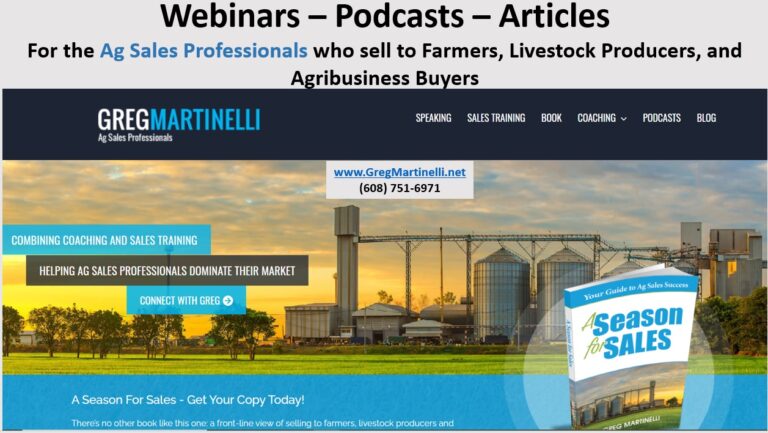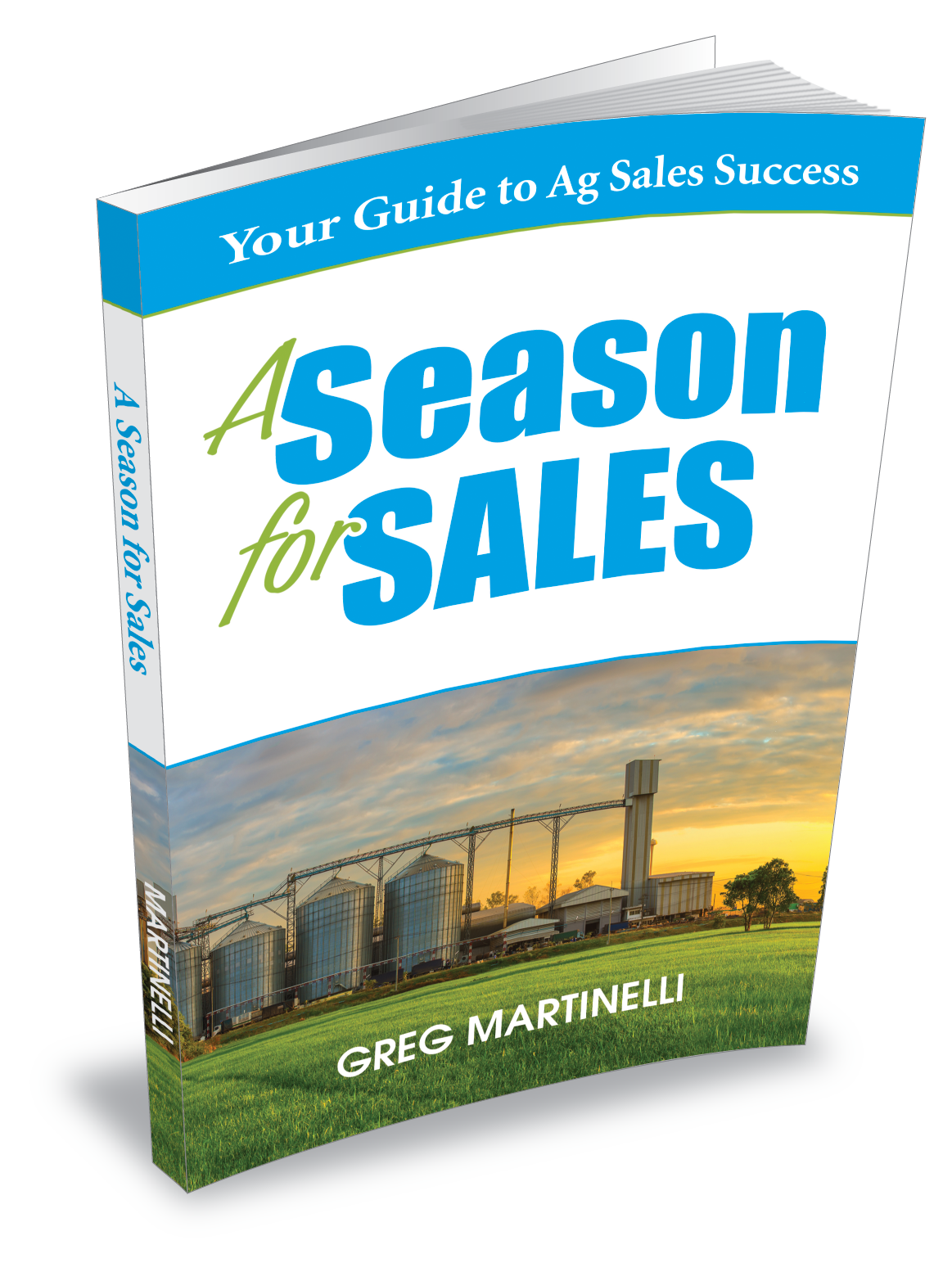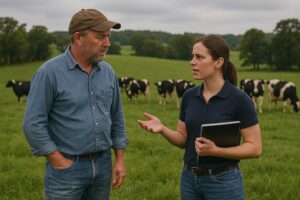As kids, we’re curious. We ask a lot of questions. Back in the day, we were told to quit asking dumb questions. Then we were told that there are no dumb questions. But we grew up, got busy and simply stopped developing our sense of curiosity. However, in sales, curiosity is one of the tools you can pull from your tool belt and help improve your results. In doing so, you also help grow your customer’s business.
As adults, we get into comfortable ruts. We don’t aim to, but we do. As an Ag Sales Professional, you also get into a rut. You drive the same roads to get to your same customers, week after week, month after month. You call on certain customers at the same time, cover the same topics and sell them the same products. You go to the Farm Progress or state Ag show and set up the same booth in the same spot with the same brochures you always do.
With Ag customers, we are usually in long term selling relationships. We start off selling them some initial products. Then, we add a few more products to their buying pattern. But eventually, they level off on buying anything new from us. We are happy for the sales and don’t want to rock the boat. So, we accept this level of sales and level off our selling strategy with this account. Without realizing it, we just sank into a rut.
Below are three curiosity techniques and development strategies to shake up that routine. The end result is more sales for you and improved results for your customer.
#1: Questions: Learning to dig deeper and go just a little further than you normally do, you will yield some great information and help your customer. Physically tour their facility with them. Look through your records on their purchases. If allowed, look at their results on paper with them. What doesn’t make sense to you? What are they doing that others aren’t? What are they not doing that others like them are? Are their numbers similar to others like them? Which ones are drastically different? What industry benchmarks are they above or below? What would happen to their bottom line if they hit those benchmarks? What will happen to their farm if they don’t?
One recommendation when using questions; remove the “Why” form in your questions. First, it can seem like an interrogation when someone continues to ask Why you do what you do. Secondly, when you ask Why, the other person has to now defend their decision. We don’t want that. So, use “What, How, When and Where” formats to get better results. I know you really want to ask, “Why do you buy from Acme Agribusiness (your competition)?” However, this will push your prospect into defending their decision. To do that, your prospect will come up with all the good things about Acme. Maybe even embellishing to justify their decision. Instead, you might ask, “How long have you been a customer of Acme? What was it that drew you to them?” After they answer, you might ask, “Is that still true of them today?” The answer you get to this question can unlock a lot of information. Companies change over time; both this prospect and their vendors. An agribusiness company is rarely the same today as when a producer or agribusiness selected them as their vendor in 1990.
Other great questions include:
- “And what else?” This is a tag on to the end of their answer to a question. For example, they tell you about a pain point they are having. You ask, “Are there any other problems this causes? Or “What else does this cause?” The prospect digs just a little deeper as they try to answer your question. You can continue this question each time the customer gets done answering. That is until your customer runs out of answers or you feel you are becoming annoying.
- “What do you think should happen? Or What do you want to happen right now? Or What do you think I should do right now?” These are great curiosity questions after a customer gets done venting on a problem or issue, they are having. Their answer will tell you whether or not they want action or just need to vent.
#2: Travel: Yes, I know we are in the middle of a Stay-at-Home time frame, but that will not last forever. When it does lift, get out of your comfort zone and discover how agribusiness is done in other parts of the world. If you are a nationwide company, then you have the opportunity to visit your internal teammates. If not, maybe check with a vendor from the geography you want to go to. They might have some insight on where you could go when you travel there. Without exposure to other geographies, many of us reinvent the wheel. Worse yet, we endure through problems others have already solved. Through travel to other sales areas, I found several new products, a solution to an insect infestation, and adopted numerous short cuts to managing a sales territory.
Additionally, these new connections were able to learn from what we were doing in my region. These connections became lifelong learning opportunities for all involved.
#3: Do Something Different: Many of us see something and think we know what it’s all about or what it’s like. I can’t tell you how many times I have been reminded that seeing something happen and actually experiencing it are very different. About 15 years ago, we were sponsoring a horse trainer that was a world champion at reining. This is where a horse spins on a dime, then corrals a calf along a fence and finally sprints to one end of the arena into a four-legged slide. Seeing this trainer do it with ease and knowing that even kids do it, I accepted the challenge to jump on his horse and give it a whirl. As a novice rider, once on top of the horse and about to spin, I immediately grabbed on with both hands (not supposed to do that). After spinning and chasing a calf down the arena fence, our trainer bailed me out of doing the slide. “The arena footing wasn’t conducive to sliding.” I had an immediate change of opinion on how hard it was to get a horse trained and to actually do reining.
How can you do this in sales, without riding a horse? Internally, go sit with your customer service person, truck dispatcher, accounts receivables person, marketing department person, etc. Get curious about how they do their job, what it takes, what makes it difficult and how we (as a company) can be better. That doesn’t just mean – how can sales help them do their job better. It also means, how can both of us create a new or better way to go-to market. For example, you sit with accounts receivables and see that there are things you could do to make their life easier. Great, do them. But curiosity should come into play as you ask them to come up with better ways you can implement A/R strategies to help customers. Here’s an example – time your credit terms to the customer’s income schedule.
Externally, the first step is to go to the very point of your product being used by the end user. If you haven’t seen this in action, stop what you are doing until you have. When someone tells you how good or how bad a product is, go immediately to the sight and see it for yourself. You will be amazed at the number of times when it’s a lot worse or not as bad as what the customer described. Why, because your opinion and your customer’s opinion of good and bad are most likely different. So, go see for yourself and start asking a lot of questions.
I will leave you with this final tip and thought. Take a small sticky note or 3X5 card and just write the word “Curiosity” in big letters on it. Keep it on your dash somewhere or in a notebook. When you are struggling with what to say or do, look at it and start asking curiosity questions. In a recent example, I was working with a sales manager to develop a sales training program customized to his team. He was fairly sure of what he wanted for his team at the beginning of our discussion. Implementing my natural curiosity, I went through a series of questions that uncovered a different need for his team. Had I jumped on the first part of our discussion; I would have designed training on the wrong skills. Curiosity helped us arrive at the best training solution.
If this article helped you on your journey to being more effective in your selling, I ask you to share it with those who might also benefit from it.
Sign up for my weekly blog and podcast using the links in this email.
As a final request, take a look at the newest book on the market written specifically for you!
A Season for Sales: Your Guide to Ag Sales Success
The only book written specifically for the Ag Sales Professional, by an Ag Sales Professional!





